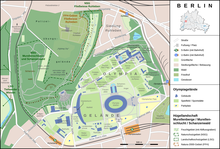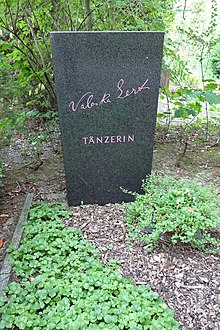Ruhleben cemetery
The state-owned Ruhleben cemetery in the Westend district of Berlin (location Ruhleben ) is a park cemetery with a size of 13.9 hectares that has existed since 1952 . The "Crematorium Ruhleben", which has been in operation since 1975, is located on its premises.
history
After the Second World War , an emergency cemetery for around 4,000 war victims, both soldiers and civilians, was created on the Berlin exhibition grounds in the area of today's Hall A. In 1947 the Allies demanded that the cemetery be closed. Since the south-west cemetery in Stahnsdorf could no longer be used without restrictions, an area was sought for a new cemetery in West Berlin . An area was chosen near the Ruhleben settlement, which had previously served as a parade ground and as a location for an anti-aircraft battery during World War II (the last remains were not removed until 1968). It is located on the northern foothills of the Murellenberge , a vistula-glacial hilly area made up of compression and terminal moraines in the northern band of the Teltow plateau , which slopes down to the Berlin glacial valley. To the east the cemetery limits the valley of today's nature reserve flow field Ruhleben , a silting Moores , which forms the northern extension of the Trockentals Murellenschlucht. To the west, the cemetery area merges into the Schanzenwald , which is already part of the valley sand area of the Spreeniederung in the glacial valley. The planned size of the cemetery was 22 hectares, whereby only 16 hectares could be used for the time being, as the remaining area in the southern part was initially used as a military training area for the Allies (today the Berlin police training area ).
In 1950 the construction of the cemetery began. The area was afforested with spruce , pine and birch . The grave fields were bordered with bushes. The inauguration took place on August 17, 1952. A temporary facility was built for the festivities, which was used until the inauguration of the crematorium and which today serves as a storage room. Most of the approx. 4,000 burials from the Eichkamp temporary cemetery were reburied here. Quite strict regulations that z. B. forbid the enclosure of the graves should preserve the character of the cemetery, as a park cemetery with strong echoes of a forest cemetery . In the eastern cemetery area, as a reminder and reminder of the war victims, the sculpture War Victims' Mark by Karl Wenke, created in 1951 from shell limestone , was set up in the area of a war cemetery. In 2003, Otto Hitzberger's sculpture of a mourner, created by 1927 at the latest and donated, brought another work of art to the cemetery.
Ruhleben crematorium
After access to the Berlin-Baumschulenweg crematorium was no longer available in the post-war period and the Wilmersdorf and Wedding crematoriums reached their capacity limits, the Berlin Senate decided to build another crematorium. For this he selected an unoccupied area in the Ruhleben cemetery.
A competition for the design of the new building was announced in 1962, to which 52 designs were submitted. A design by Jan and Rolf Rave was honored and selected for implementation in April 1963 . The jury at the time believed that this design would break “the dividing line between pathos and technology”. After the clarification of the financing took a long time, construction began in 1972. The crematorium was inaugurated in March 1975. The construction costs came to a good 18 million DM in the end .
The crematorium received two basement floors in which the four ovens and generously dimensioned storage rooms for corpses were built. The reason for the high storage capacity is that even in the event of a disaster, epidemic or pandemic , it should be possible to store up to 1000 corpses in a hygienically perfect manner. The rooms in the basement are accessed from the west side through a lower farm yard. The ground floor is designed as a three-compartment system, with two trains being used for funeral services and the central train being used for operating rooms and custody . The western train has a mourning hall for 160, the eastern one for 60 people. Both trains are traversed by the mourners from north to south. To the north of the crematorium there is a paved forecourt from which the structurally identical buildings can be accessed. First the mourners arrive in a waiting room. From there it goes south to the respective mourning hall, which in turn is left to the south into an open condolence court . From the two courtyards of condolence, exits lead south into the cemetery. The architects have chosen this form of wandering through the building so that a mourning party does not encounter the following mourning party when they leave the building.
The architecture of the crematorium is industrial and works mainly with untreated materials such as hollow concrete blocks for the walls and copper for the roofs. Paint coatings were only used on doors and window frames. The entrances to the forecourt "at first glance give the impression of garage entrances". The celebratory halls, the ceiling height of which has been increased by gable roof-like structures with skylights, are decorated with large wall paintings by Markus Lüpertz , which deal with the themes of death, destruction and the hope of eternity.
As part of the construction of the new crematorium, some outbuildings were built. Two service houses, an administration building and a flower shop were built at the redesigned cemetery entrance on the street Am Hain. A wide path to the forecourt in front of the crematorium was laid parallel to an older avenue of fir trees in the cemetery. A narrow building with staff rooms and an emergency power generator serves as the western end of the forecourt . A bell tower was erected southeast of the crematorium so that the funeral parties can pass the bell tower via the condolence courts after leaving the crematorium.
Twelve years after the crematorium was put into operation, the incineration plant was brought up to date from 1987 to 1989 for 9 million DM. The Wilmersdorf crematorium was then closed. Around 10,000 corpses are currently cremated each year in the Ruhleben crematorium.
Buddhist burial ground
On August 3, 2003, the first Buddhist burial ground in Berlin was inaugurated at the Ruhleben cemetery . This field in the back of the cemetery is used by the Vietnamese Buddhist community in Berlin to bury their dead. The facility is designed for 100 earth and 600 urn burials. In the center, a 4.30 meter high statue of the Bodhisattva Tian Tan was placed, a Bodhisattva who, out of love for all living beings, did not go into nirvana to help everyone out of Hell until no living beings live there.
Well-known personalities buried
(* = Honor grave of the state of Berlin)
- Valeska Gert * (1892–1978), dancer and actress
- Werner Gocksch (1922–2006), painter and illustrator
- Robert Wolfgang Schnell * (1916–1986), writer
- Arnold Słucki * (1920–1972), Polish writer
literature
- Birgit Jochens, Herbert May: The cemeteries in Berlin-Charlottenburg / History of the cemetery facilities and their tomb culture . Stapp Verlag, Berlin 1994, ISBN 3-87776-056-2 .
- Berlin and its buildings / Part X Volume A Systems and buildings for supply / (3) Funeral services . Verlag von Wilhelm Ernst & Sohn, Berlin, Munich 1981, ISBN 3-433-00890-6
- Hans-Jürgen Mende: Lexicon of Berlin tombs . Haude & Spener, Berlin 2006, ISBN 3-7759-0476-X .
supporting documents
- ↑ List of Berlin cemeteries (PDF; 84 kB) of the Berlin Senate Department for Urban Development
- ↑ Murellenschlucht and Schanzenwald nature reserve . In: Senate Department for Urban Development Berlin: Berlin of course! Nature conservation and NATURA 2000 areas in Berlin. Verlag Natur & Text, Berlin 2007, pp. 120–123. ISBN 978-3-9810058-3-7
- ↑ Karl Wenke, Kriegsopferzeichen ( page no longer available , search in web archives ) Info: The link was automatically marked as defective. Please check the link according to the instructions and then remove this notice. in the "Sculpture in Berlin" catalog
- ↑ Otto Hitzberger, Mourners ( page no longer available , search in web archives ) Info: The link was automatically marked as defective. Please check the link according to the instructions and then remove this notice. in the "Sculpture in Berlin" catalog
- ↑ Jan Rave, Rolf Rave: Crematorium in Berlin-Ruhleben . In: Bauwelt, 66th year (1975), issue 42, p. 1161
- ↑ Berlin and its buildings: Bestattungswesen, pp. 77–79
- ↑ Jochens / May, p. 88
- ↑ Jochens / May, p. 89
- ↑ The Savior in Hell is here . In: Die Tageszeitung, August 4, 2003.
- ↑ Honorary graves of the State of Berlin (as of January 2009) (PDF; 566 kB)
Web links
- Cemetery and crematorium Ruhleben in the Lexicon of the Charlottenburg-Wilmersdorf district
- Website of the crematorium Ruhleben
- Information on the Berlin-Ruhleben crematorium on the website of the Charlottenburg-Wilmersdorf district
Coordinates: 52 ° 31 '25.1 " N , 13 ° 13' 47.8" E






